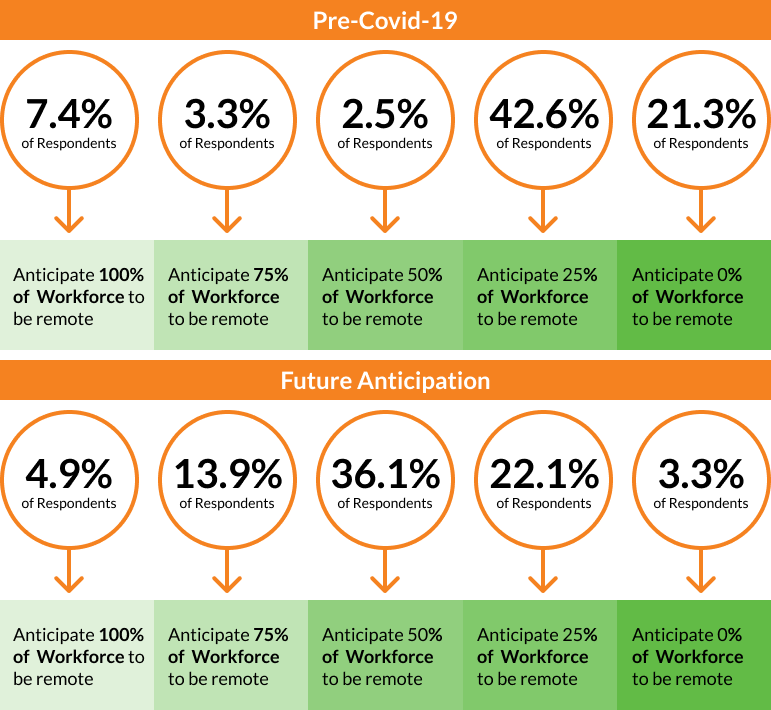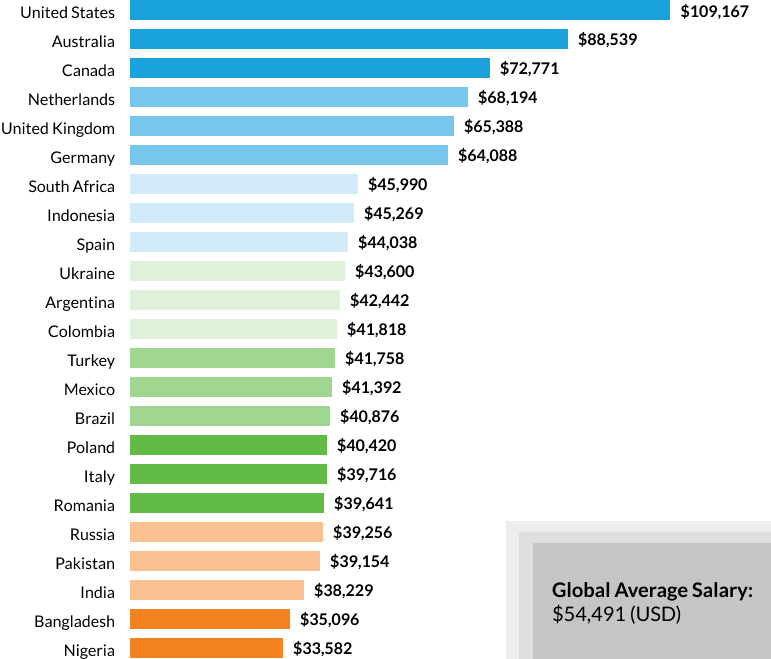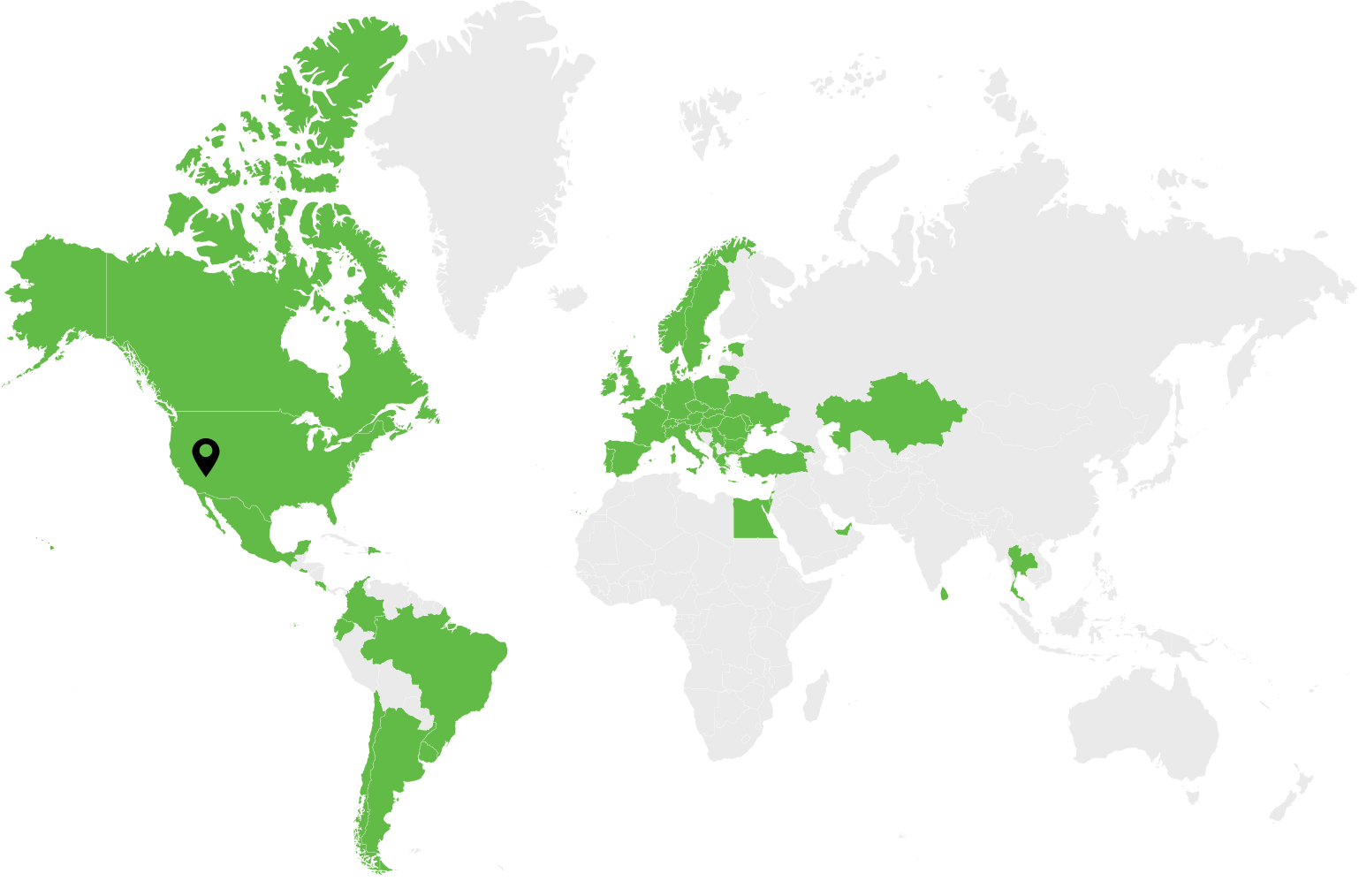To hire a remote team means to save on office costs and increase productivity. It also opens your company up to the world of outsourcing, which can help increase your competitive edge. During a long-term project, this can be the difference between your company’s survival and demise.
Remote work is increasingly popular across industries:
- A recent survey found that an overwhelming majority — 97% — of employees say they don’t want to go back to the office full time.
- That same study, which surveyed 520 remote employees and employers from 35 countries, revealed that remote work is a major advantage for new team members. If a job doesn’t have a remote component, candidates are likely to move on to other options.
According to a Deloitte survey of 122 corporate HR mobility professionals, 36% expect at least half of work to be out of office [as compared to just 2.5% pre-COVID] and only 3.3% expect work to be completely office based [as compared to 21.3% to pre-COVID].

Source: Deloitte
As a software development vendor that has operated on a remote model for several years, we have first-hand experience with this approach, including:
- How to hire an effective remote team
- Things to consider when hiring a software engineering team
- How to best integrate the in-house and remote outsourced teams
Before going into the algorithm of recruiting remote team members for your hybrid teams, let’s consider some of the strengths and weaknesses of the three types.
Pros and Сons of In-House and Remote Outsourced Teams
Let’s take a look at the pros and cons of in-house and outsourced teams.
| Inhouse Team | Outsourced Remote Team | Hybrid Remote Team | |
| Involvement in the recruitment process | High | Low | Middle |
| Loyalty | High | Middle | High |
| Security | High | High | High |
| Legal and intellectual risks | Low | Middle | Middle |
| Recruitment costs | High | Middle | Middle |
| Scalability | Low | High | High |
| Access to global talent | High | High | High |
While in-house teams have their own limitations, hybrid remote teams offer quick access to new markets. If you have a team extension in Belarus or Ukraine, it’s much easier for your company to set up a marketing office in that country. This can help you rapidly scale your monthly active users [MAU] in the vast Russian-speaking market.
In addition, many vendors will own or rent real estate in their country of residence, allowing you to take advantage of the in-house hybrid model without upfront investment into office rental in new markets.
Hiring an Effective Remote Team Via a Vendor: Algorithm for Distributed Hybrid Models
Distributed teams or extension teams usually tend to develop as a natural evolutionary stage for the established companies with an effective inhouse development crew, strong traction, initial investment, who need to scale fast based on contractual obligations.
Here is a blueprint for decision-making in such a case:

1. Define Your Starting Point and End Goal, as Well as a Deadline and Budget
For example:
Point A: you are a scale-up company that has received series A funding, has a working product, and monthly active users of 50K+ in a poorly saturated niche.
Point B: you need to enrich your product by a set of specific features and grow MAU to 1 million users over 5 markets.
Deadline & Budget: you want to get from point A to point B in 2 years so that you can start a Series B round. You have $5 million in series A funding to use for this project.
2. Decide on the Location of Your Outsourced Team
India, Eastern Europe, and LatAm countries are all popular regions for software development outsourcing.
Things to consider when choosing the location of your extended team [with Ukraine as example in brackets from a US client’s perspective]:
- Cultural differences [minimal cultural differences with the US, 87% Orthodox Christians, Internet penetration 82%].
- English language proficiency in the area [moderate proficiency, 44th out of 100 countries in region].
- Time zone difference [Kyiv is 7 hours ahead of New York, GMT +3 vs GMT -4; overlapping working time is 9 AM – 12 PM in Washington, DC, which is 4 PM – 7 PM in Ukraine].
- Average tech skills in the country and the state of STEM [science, technology, engineering, mathematics] education [212K developers and 16K tech graduates annually].
- Average remuneration levels for the talent pool you require and how significant is the delta in comparison with your country of residence [average programmer’s salary is $43,600 per annum in Ukraine vs $109,167 in the US]. Engagement model are critical for correctly estimating your personnel expenses for the project [fixed per-project cost, time and materials, or dedicated team].

Source: Hackerrank
3. Choose the Form of Your Cooperation [Decide on the Level of Responsibility for Team and Delivery]
One of the most critical decisions you will make when hiring an extension or remote team is the way these subcontractors engage with your company.
Before commissioning a chunk of work on a fixed project basis or hiring an extension team for your DevOps, consider the following points:
- How much involvement do you want in the recruitment, administration, project management, legal issues, and payroll processing parts of the project?
- Who is going to drive the strategic role distribution and who is going to be responsible for overall project delivery?
- Are you prepared to employ outsourced team members for exclusive long-term use or do you need to boost your team for a short-term only by specific talent?
- Do you want the remote part of the team to be aligned with your company’s corporate culture and work under your brand name?
- Are you ready to discuss partial remuneration in the form of stock options for the software development services, saving yourself cash and boosting motivation for your tech partner?
Once you have answered all of the questions above, you will know exactly which approach will work best for your company: fixed pay, time-and-material, or a dedicated team engagement model.
4. Outline Your Technical Requirement in an RFP [Request For Proposal]
You may want to provide vendors with additional information.
A few things to mention in your RFP:
- Brief bio of your company, C-level team, product description, and investments.
- Short description of the current in-house development team.
- A general outline of the product development stage, revenue, and MAU [point A].
- A general understanding of deliverables and deadlines [point B].
- Your vision for the number of staff you need and the skills they should have.
5. Select a Vendor Through a Rigorous RFP Process
Once you have selected the country and form of collaboration, and have the RFP ready, it’s time to select a software development vendor.
Make sure to:
- Select 5-7 companies based on industry ranking lists and recommendations.
- Add to the list 2-3 companies with a solid portfolio but lower public profile [500+ employees and 7+ years on the market is ideal]. Such companies focus on getting the job done instead of rank-hunting, and are likely to be more flexible than the awarded counterparts across the board of contractual criteria.
- Send your RFP and make your decision based on:
- Quality and speed of responsiveness
- Average time-to-hire
- Discipline and corporate culture exhibited during the RFP process
- Similar cases on profile
- Detail of the documentation provided and clarity of the process
- Conduct Zoom Q&A sessions to see if communication is up to par.
- Send notifications to shortlisted companies.
- Conduct talks before the final selection and negotiations.
6. Provide Your Partner with the Scope of Work and Your Recruitment Requirements
Once the requirements are established, it’ll take some time before resumes start rolling in. Depending on the market saturation at the moment of talent-hunting, it can take anywhere from four to eight weeks to land a new hire.
From our experience, tech leads and solution architects are of the biggest value for a project’s success, so we recommend grabbing the right candidate even if the salary expectation level requested is slightly above the market rate. The return on investment is usually worth it.
While it is the responsibility of a software development outsourcing partner to screen a talent pool of 200-400 candidates for each position, a client may want to approve the shortlisted candidates themselves.
7. Start Conducting Interviews with Candidates
When we hire for key positions, DevPro has a multi-step interview process that includes all major stakeholders. This ensures that in-house and outsourced staff are in sync throughout the process. When a company is unsure of who to hire for a pivotal role, we sometimes encourage the client to hire two candidates and compare their performance during a trial period.
While this is the end of the algorithm on how to hire an effective remote distributed team, it’s only the start of your journey with this diverse crew of talent!
It’s now time to think how to seamlessly blend them into one smoothly functioning organism.
How to Mesh an Outsourced Team with Your Company’s In-House Staff?
Guess what? We have an entire article on this exact topic!
Here are some of the key takeaways:
- Provide maximum visibility for both parts of the team [in-house and outsourced] at every step.
- Ensure regular communication [scrum meetings, nexus standups, retros] using channels that are convenient for both teams [Jira, Teams, Confluence]
- Create social settings for the teams to bond, including extracurricular activities, team building exercises, and informal chats.
Hybrid Distributed Team Recruitment: How to Support Further Growth
Scale-ups often involve extreme pressure from seed investors to prove that a company can operate in a new market and show exponential MAU growth.
With plenty similar tech products entering the market, it’s a sprint only the fastest will win. Moreover, with hybrid teams being the golden standard for the tech industry, the average burn rate expectations from investors are going down.
A thorough market research, business intelligence, and meticulous screening process can make your scale-up easier and more stable. The best way to go about this is to find a reliable IT outsourcing services partner.
DevPro is a U.S.-managed and Ukraine-based company with more than a decade of experience helping companies scale up sustainably and transparently. Contact our sales team to find out how we can augment your company’s growth.

